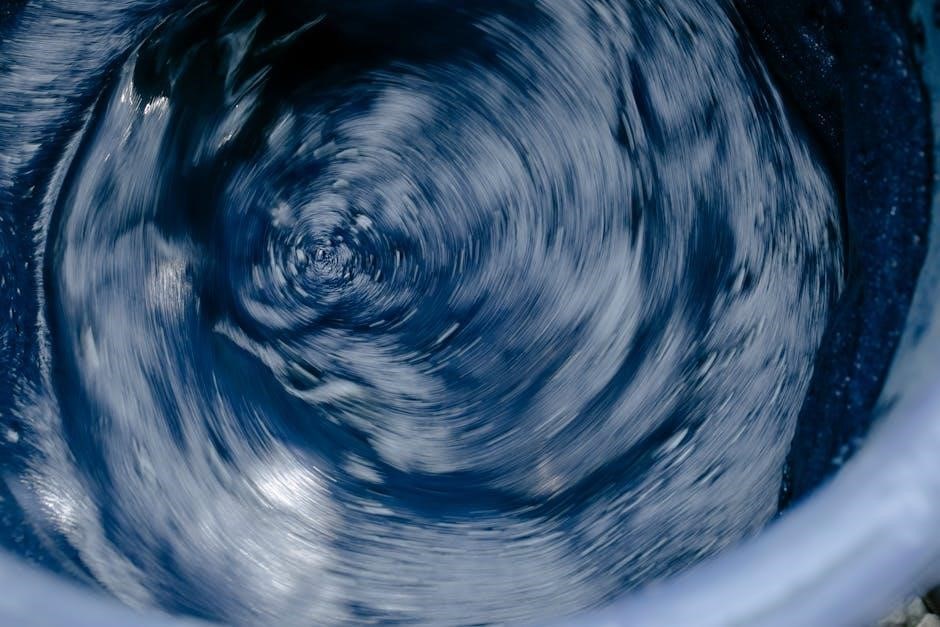whirlpool washing machine user manual
Welcome to the Whirlpool Washing Machine User Manual! This guide provides comprehensive instructions for safe operation, maintenance, and troubleshooting to help you get the most out of your appliance.
1.1 Purpose of the Manual
This manual is designed to guide you in safely operating, maintaining, and troubleshooting your Whirlpool washing machine. It provides detailed instructions to help you understand the appliance’s features, optimize performance, and ensure longevity. By following the guidelines, you can enjoy efficient laundry care while adhering to essential safety precautions. This resource is your go-to for resolving issues, updating settings, and making the most of your washing machine’s capabilities.
1.2 Structure of the Manual
This manual is organized into clear sections for easy navigation, ensuring you can quickly find the information you need. It begins with an introduction, followed by safety precautions, parts and features, installation, operation, maintenance, troubleshooting, and additional resources. Each chapter is divided into sub-sections, providing detailed guidance on specific topics. This structured approach ensures that you can efficiently use, maintain, and troubleshoot your Whirlpool washing machine with confidence and ease.
1.3 Important Safety Precautions
Always follow safety guidelines to ensure safe operation and longevity of your Whirlpool washing machine. Read all instructions carefully before use and avoid washing items cleaned with gasoline or flammable substances. Ensure proper installation and leveling to prevent accidents. Keep children supervised and avoid overloading the machine. Regular maintenance, such as cleaning filters and checking connections, is essential. Adhere to these precautions to guarantee optimal performance and safety for years to come.

Safety Precautions
Always follow safety guidelines to ensure safe operation and longevity of your Whirlpool washing machine. Read all instructions carefully before use and avoid washing items cleaned with gasoline or flammable substances. Ensure proper installation and leveling to prevent accidents. Keep children supervised and avoid overloading the machine. Regular maintenance, such as cleaning filters and checking connections, is essential. Adhere to these precautions to guarantee optimal performance and safety for years to come.
2.1 General Safety Guidelines
Always read the manual thoroughly before operating your Whirlpool washing machine. Ensure proper installation and leveling to prevent accidents. Keep children supervised and away from the machine during operation. Avoid washing items cleaned with gasoline or flammable substances. Do not overload the machine, as this can cause imbalance and damage. Regularly inspect and maintain the appliance to ensure optimal performance. Follow all safety instructions provided in the manual to guarantee safe and efficient use of your washing machine.
2.2 Electrical Safety
Ensure your Whirlpool washing machine is properly installed and grounded to prevent electrical hazards. Avoid overloading circuits, and keep the power cord away from water. Never operate the machine with damaged cords or plugs. Unplug it during installation, maintenance, or if it malfunctions. Avoid using extension cords unless necessary, and always follow the manufacturer’s guidelines for electrical connections. Regularly inspect electrical components for wear and tear to ensure safe operation.
2.3 Chemical Safety
Use only recommended detergents and chemicals to avoid damaging your Whirlpool washing machine or causing harm. Avoid overloading with detergent, as this can lead to residue buildup. Never mix different cleaning agents, as they may produce hazardous fumes. Keep all chemicals out of children’s reach and follow the manufacturer’s instructions for proper usage.
Regularly clean the detergent dispenser and gasket to prevent mold and mildew. Run the ‘Clean Washer’ cycle with affresh® tablets to maintain hygiene. Always dispose of chemical waste responsibly and refer to the manual for specific guidelines on safe chemical use.
2.4 Child Safety
Ensure children stay away from the washing machine while it’s in operation. Keep the lid closed when not in use to prevent accidental access. Store detergent and cleaning agents out of reach. Supervise children during laundry tasks and teach them to never play with the machine or its controls. Regularly check for and remove any small objects that could pose a choking hazard. Always lock the controls if the feature is available to prevent unintended operation by children.
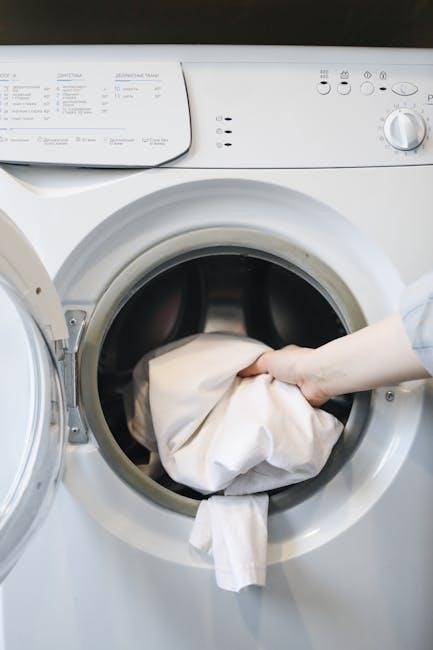
Parts and Features of the Whirlpool Washing Machine
This section details the exterior and interior components, including the control panel, detergent dispenser, and tub. Understanding these features ensures optimal use and maintenance of your appliance.
3.1 Exterior Components
The Whirlpool washing machine features a durable exterior design with a robust lid, control panel, and detergent dispenser. The exterior includes a sturdy base, side panels, and a user-friendly interface.
The lid provides easy access to the interior, while the control panel offers intuitive buttons and knobs for cycle selection. Exterior components are designed for longevity and ease of use, ensuring efficient operation and minimal maintenance. These features enhance the overall user experience and durability of the appliance.
3.2 Interior Components
The interior of your Whirlpool washing machine includes the inner tub, outer tub, pulsator, and drain pump.
The inner tub holds laundry and rotates during cycles, while the outer tub contains water. The pulsator agitates clothes for effective cleaning, and the drain pump ensures water is removed efficiently. These components work together to optimize wash performance, ensuring clothes are cleaned thoroughly while maintaining energy efficiency and durability. Proper maintenance of these parts is essential for long-term functionality and reliability.
3.3 Control Panel Overview
The control panel is the command center of your Whirlpool washing machine, featuring buttons, knobs, and a digital display. It allows you to select wash cycles, temperature settings, and additional options like spin speed or fabric care. The panel also displays cycle progress, error codes, and remaining time. Intuitive design ensures easy navigation, while customizable settings enable tailored washing experiences. Regularly cleaning the panel and checking for software updates helps maintain optimal performance and functionality over time.
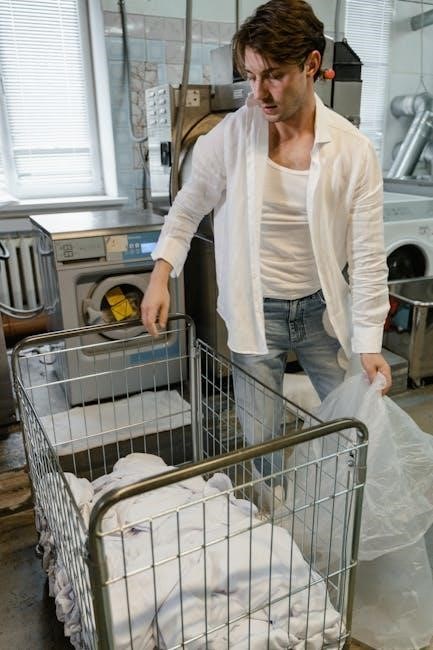
Installation and Setup
Proper installation ensures optimal performance. Prepare the site, level the machine, connect water and drainage, and complete initial calibration for smooth operation and functionality.
4.1 Preparing the Installation Site
Ensure the installation site is level, stable, and dry. Check the floor for evenness and durability to support the machine’s weight. Clear the area of obstacles and ensure proper ventilation. Verify that the site is protected from direct sunlight and extreme temperatures. Measure the space to confirm it fits the washer’s dimensions. Ensure nearby water and drainage connections are accessible. If the site isn’t suitable, consult a professional for modifications before proceeding with installation.
4.2 Leveling the Washing Machine
Proper leveling ensures stability and prevents noise or vibrations. Place the washer on a firm, even surface. Check the floor for levelness using a spirit level. If uneven, adjust the machine’s legs by turning them clockwise or counterclockwise. Ensure all four feet touch the floor firmly. Tighten the legs securely after leveling. Double-check the balance by rocking the machine gently; it should remain steady. Proper leveling is essential for optimal performance and to avoid damage during operation.
4.3 Connecting Water and Drainage
Connect the washing machine to a cold water supply using the provided inlet hoses. Attach the hoses securely to the machine’s water inlet ports, ensuring they are not kinked or twisted. Connect the other ends to the household water supply valves. For drainage, position the drain hose over a standpipe or into a sink drain. Ensure the hose is not submerged or bent. Check all connections for leaks before first use. Proper installation ensures efficient water supply and drainage for optimal performance.
4.4 Initial Setup and Calibration
Plug in the washing machine and ensure all connections are secure. Set the language and date using the control panel. Select the appropriate water hardness and soil level settings based on your preferences. Run a calibration cycle without laundry to ensure proper water level and detergent dispenser function. Check for any leaks during this process. Once complete, your machine is ready for regular use. Proper calibration ensures optimal performance and prevents issues during operation.

Operating Instructions
Load laundry, select the appropriate cycle, and add detergent. Choose options like soil level and temperature. Start the cycle and let the machine complete the process. Ensure the lid remains closed during operation for optimal performance and safety.
5.1 Loading Laundry
Sort clothes by fabric type and color to prevent damage. Check pockets for loose items. Load evenly, avoiding overfilling. Use the detergent dispenser for optimal results. Delicates should be placed in a mesh bag. Ensure bulky items like towels are balanced. Close the lid securely after loading. Proper loading ensures efficient washing and prevents damage to clothes and the machine.
5.2 Selecting Wash Cycles
Select the appropriate wash cycle based on fabric type and soil level. Use the cycle knob to choose options like Heavy Duty, Normal, or Delicate. LED indicators will confirm your selection. For heavily soiled items, opt for longer cycles with higher agitation. Delicates require gentle settings to prevent damage. Always refer to the cycle guide for specific recommendations. Proper cycle selection ensures optimal cleaning while protecting your fabrics.
5.3 Using Detergent
Use the recommended amount of detergent for optimal cleaning. Measure detergent according to load size and soil level. Place detergent in the designated dispenser drawer, ensuring proper distribution. For best results, use high-efficiency detergent for low-sudsing performance. Avoid overloading the dispenser, as excess detergent can leave residue. Eco-friendly detergents are compatible with Whirlpool machines, promoting sustainability. Always follow the detergent manufacturer’s guidelines for dosage and type to ensure efficient cleaning and appliance longevity.
5.4 Starting the Wash Cycle
Select the desired wash cycle using the control panel or knob, ensuring it matches your laundry load type. Press the Start button to begin the cycle. Make sure the lid is properly closed before starting. The machine will automatically detect load size and water level. Once started, the washer will proceed through the selected cycle, including pre-wash, wash, rinse, and spin phases. Verify detergent dispenser is filled and settings are correct before starting the cycle for optimal performance.
5.5 Pausing or Stopping the Cycle
To pause the wash cycle, press the Start/Pause button. The machine will temporarily halt, allowing you to add forgotten items. Ensure the lid is securely closed to resume. If you need to stop the cycle completely, press and hold the button until the cycle cancels. Note that stopping mid-cycle may leave clothes soaking. Always follow the control panel instructions for safe interruption and resumption of the wash cycle. This ensures proper function and prevents damage to your laundry or the machine.
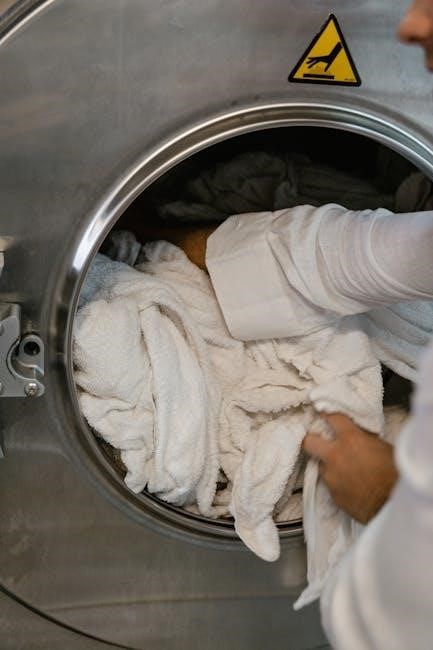
Maintenance and Troubleshooting
Regularly clean the washer and check for blockages to ensure optimal performance. Refer to specific troubleshooting guides for common issues and error codes to resolve problems quickly.
6.1 Regular Cleaning of the Washer
Regular cleaning ensures your Whirlpool washing machine runs efficiently and prevents odors. Clean the gasket and detergent dispenser monthly. Run a cleaning cycle with a washer cleaner like affresh® to remove buildup. Leave the lid open after use to dry the interior. Check and clear debris from the drain pump filter regularly. Proper maintenance helps maintain performance and extends the lifespan of your appliance. Follow the manual for specific cleaning instructions tailored to your model.
6.2 Checking and Replacing Parts
Regularly inspect parts like the drain pump filter, gasket, and detergent dispenser for wear or blockages. Refer to your Whirlpool manual for specific guidance on checking and replacing components. Use genuine Whirlpool parts to ensure compatibility and performance. If a part is damaged, replace it promptly to prevent further issues. For complex repairs, consult a professional. Always follow safety precautions when handling electrical or moving parts. Proper maintenance extends the lifespan of your washing machine and ensures optimal performance.
6.3 Common Error Codes
Your Whirlpool washing machine may display error codes like F1, F2, or F3, indicating specific issues. These codes help diagnose problems such as sensor malfunctions, drainage issues, or lid lock failures. Refer to your user manual for a detailed list of codes and their meanings. For example, F1 often relates to a lid lock problem, while F2 may indicate a drainage issue. Always follow the troubleshooting steps provided or contact customer support for assistance. Regular maintenance can help prevent these errors and ensure smooth operation.
6.4 Resolving Common Issues
Identify and resolve common issues quickly by referring to your user manual. Error codes like F1 or F2 indicate specific problems, such as lid lock or drainage issues. Regularly clean filters and check for blockages to prevent errors. For persistent issues, run a cleaning cycle or reset the machine. If problems persist, contact Whirlpool customer support for assistance. Regular maintenance and troubleshooting tips are available online to help you address common concerns effectively and keep your washer running smoothly.
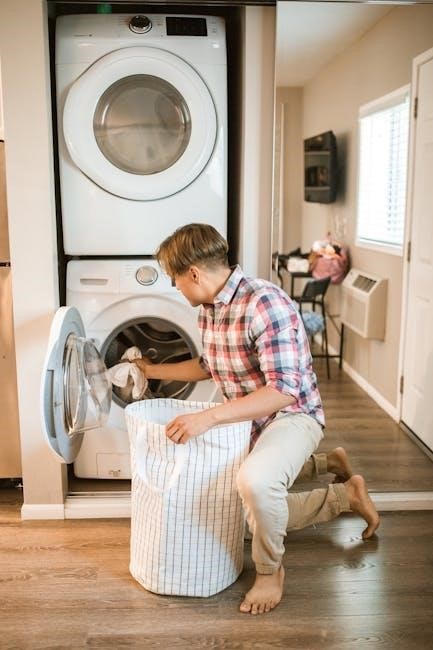
Additional Features
Discover advanced features like 6th Sense Technology for optimized washing, energy-saving modes, and smart technology integration for seamless control via your smartphone or voice assistant.
7.1 Advanced Wash Settings
Whirlpool washing machines feature advanced wash settings, including 6th Sense Technology, which automatically adjusts water and energy usage. Customize cycles for delicate, heavy-duty, or specialized fabrics like wool or silk. Select steam cleaning for deeper stain removal or sanitize cycles for hygiene. Programmable options allow you to tailor wash cycles to specific needs, ensuring optimal cleaning while protecting fabrics. These settings enhance efficiency, providing superior cleaning results with minimal fabric wear.
7.2 Energy-Saving Modes
Whirlpool washing machines offer energy-saving modes designed to reduce water and electricity consumption. The Eco mode optimizes wash cycles for lower energy use, while still delivering effective cleaning. These modes are certified by ENERGY STAR, ensuring they meet high efficiency standards. By utilizing advanced sensors, the machine adjusts water levels and temperature, minimizing waste without compromising performance. This feature is ideal for eco-conscious users, helping to lower utility bills and reduce environmental impact while maintaining superior wash quality.
7.3 Smart Technology Integration
Whirlpool washing machines feature smart technology integration, enhancing convenience and efficiency. The 6th Sense Technology adapts wash cycles to optimize performance. Remote monitoring and control via smartphone apps allow users to start, pause, or monitor cycles. Voice control compatibility with smart speakers enables hands-free operation. Additionally, the machine learns your preferences over time, offering personalized settings. This intelligent system ensures energy efficiency, tailored care for fabrics, and seamless connectivity, making laundry day smarter and easier than ever.

Downloading and Accessing the User Manual
Access the Whirlpool washing machine manual online by visiting the official website and entering your model number in the support section. Download PDFs for easy reference.
8.1 Finding the Model Number
To locate your Whirlpool washing machine’s model number, check the label inside the door, on the back, or on a removable panel. For larger appliances, it may be on the side wall or bottom. Ensure the model number is complete for accurate manual retrieval. This step is crucial for accessing the correct user manual and troubleshooting guides specific to your machine.
8.2 Downloading the Manual Online
Visit the Whirlpool website and navigate to the Support section. Enter your model number in the search field to find your specific manual. Manuals are available in PDF format for easy downloading or online viewing. This allows you to access instructions, troubleshooting guides, and feature details anytime. Ensure you download the correct manual for your appliance to maximize its performance and address any issues effectively.
8.3 Printing the Manual
After downloading the PDF manual, you can print it for easy reference. Ensure your printer is set to standard paper size (A4 or letter) and adjust settings for optimal quality. Print only necessary sections to save resources. For eco-friendly printing, use double-sided pages. This ensures you have a physical copy handy for quick guidance while using or troubleshooting your Whirlpool washing machine.
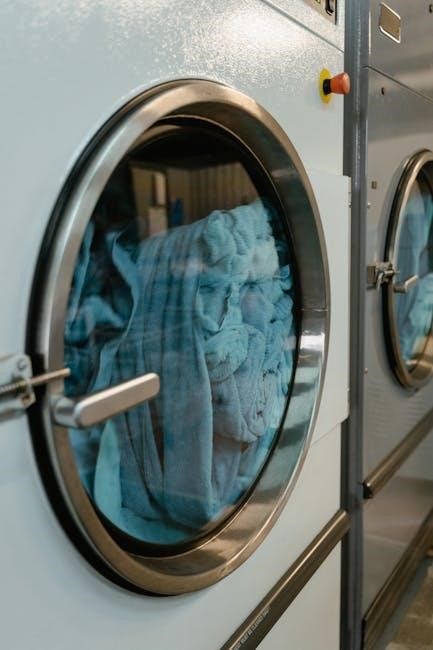
Warranty and Customer Support
Your Whirlpool washing machine is backed by a comprehensive warranty. Register your product online for extended support and easy access to repair services and troubleshooting assistance.
9.1 Warranty Coverage
Your Whirlpool washing machine is protected by a comprehensive warranty program. The standard warranty typically covers parts and labor for up to one year from the date of purchase. Extended warranties may be available for additional coverage. Register your appliance online to activate and manage your warranty benefits. Damage caused by misuse, normal wear, or unauthorized repairs may not be covered. For details, refer to your warranty agreement or contact Whirlpool customer support.
9.2 Registering Your Product
Registering your Whirlpool washing machine ensures you receive updates, warranty notifications, and easy access to support. To register, visit the Whirlpool website and navigate to the Product Registration section. Enter your appliance’s model number, found on the label inside the door or on the back, along with your contact information. This process activates your warranty and provides a record of ownership. Registration also offers access to exclusive resources and streamlined customer support services.
9.3 Contacting Customer Service
For assistance with your Whirlpool washing machine, contact customer service via phone, email, or live chat through their official website. Visit the “Contact Us” page, enter your model number, and describe your inquiry. Representatives are available to help with troubleshooting, manual requests, or warranty-related questions. Phone support is toll-free, and live chat offers immediate assistance. Ensure to have your model number ready for efficient service. Whirlpool’s customer service team is dedicated to resolving your concerns promptly and effectively.
Eco-Friendly Usage
Optimize energy and water efficiency by using eco-friendly settings. Choose low-temperature cycles and eco-mode for reduced energy consumption. Use eco-friendly detergents to minimize environmental impact while maintaining performance.
10.1 Energy Efficiency Tips
Maximize energy savings by utilizing eco-friendly settings on your Whirlpool washing machine. Always opt for the eco-mode and lower temperature cycles to reduce energy consumption. Regularly check your machine’s model number to ensure you’re using features designed for energy efficiency. Perform routine maintenance to keep your washer running efficiently. Using Energy Star-certified models guarantees superior energy performance. By following these tips, you can significantly reduce your energy consumption while extending the life of your appliance.
10.2 Water Conservation
Optimize water usage with eco-friendly settings on your Whirlpool washing machine. Use the high-efficiency (HE) wash cycles designed to conserve water while maintaining cleaning performance. Regularly check your machine’s model number to ensure you’re utilizing water-saving features. Properly loading the washer to recommended levels avoids excessive water use. Consider using eco-friendly detergents formulated for low-water cycles. Additionally, ensure the machine is well-maintained to prevent leaks and inefficiencies, helping to conserve water effectively over time.
10.3 Eco-Friendly Detergents
Eco-friendly detergents are designed to minimize environmental impact while effectively cleaning your laundry. These detergents are biodegradable, free from harsh chemicals, and low in phosphorus, making them gentler on the environment. When using your Whirlpool washing machine, opt for detergents labeled as “HE” (High Efficiency) to ensure optimal performance and water conservation. Always follow the recommended dosage to avoid residue buildup and maintain your machine’s efficiency. Eco-friendly detergents not only benefit the planet but also help extend the life of your washing machine.

Care and Maintenance Tips
Regular cleaning, checking for blockages, and using the right detergent dosage helps maintain your Whirlpool washer’s efficiency and longevity. Ensure proper ventilation for optimal performance.
11.1 Preventing Odors
To prevent odors in your Whirlpool washing machine, regular maintenance is essential. Leave the lid open after use to allow the interior to dry completely. Run a cleaning cycle monthly using a washing machine cleaner to remove mildew and bacteria buildup. Additionally, check and clean the gasket and drain pump filter regularly to eliminate debris. Proper detergent dosage and avoiding excessive fabric softeners can also help reduce residue accumulation, keeping your washer fresh and odor-free.
11.2 Checking for Blockages
Regularly inspect your Whirlpool washing machine for blockages to ensure optimal performance. Check the drain pump filter and clean it if clogged with debris. Inspect the inlet hoses for kinks or obstructions and ensure they are securely connected. Additionally, examine the detergent dispenser for residue buildup and clean it periodically. For severe blockages, disconnect the machine from power and water supply before attempting deeper cleaning. Regular checks prevent wash cycle interruptions and maintain efficiency.
11.3 Annual Maintenance
Perform annual maintenance to keep your Whirlpool washing machine in optimal condition. Clean the gasket and exterior regularly to prevent mold and mildew buildup. Run a cleaning cycle with a washer cleaner or vinegar to remove detergent residue. Inspect and replace worn-out hoses if necessary. Ensure proper ventilation in the laundry area to prevent moisture accumulation. Refer to your manual for specific instructions tailored to your model. Regular maintenance ensures efficient performance and extends the lifespan of your appliance.
